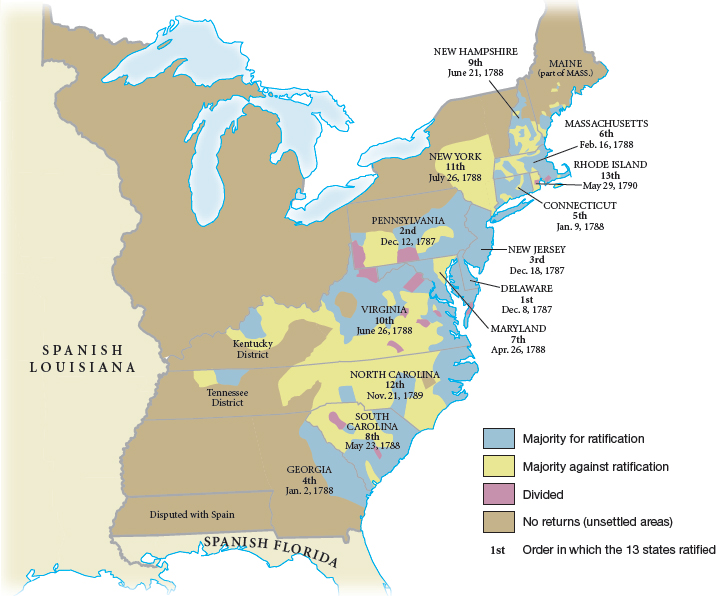The Federalists
Printed Page 227
Section Chronology
Proponents of the Constitution moved swiftly into action. They first secured agreement from an uneasy confederation congress to defer a vote and instead send the Constitution to the states for their consideration. The pro-Constitution forces next called themselves Federalists, a word that implied endorsement of a confederated government. Their opponents thus became known as Antifederalists, a label that made them sound defensive and negative, lackinga program of their own.
Federalists
 Originally the term for the supporters of the ratification of the U.S. Constitution in 1787–1788. In the 1790s, it became the name for one of the two dominant political groups that emerged during that decade. Federalist leaders of the 1790s supported Britain in foreign policy and commercial interests at home. Prominent Federalists included George Washington, Alexander Hamilton, and John Adams.
Originally the term for the supporters of the ratification of the U.S. Constitution in 1787–1788. In the 1790s, it became the name for one of the two dominant political groups that emerged during that decade. Federalist leaders of the 1790s supported Britain in foreign policy and commercial interests at home. Prominent Federalists included George Washington, Alexander Hamilton, and John Adams.
To gain momentum, the Federalists targeted the states most likely to ratify quickly. Delaware ratified in early December, before the Antifederalists had even begun to campaign. Pennsylvania, New Jersey, and Georgia followed within a month (Map 8.3). Delaware and New Jersey were small states surrounded by more powerful neighbors; a government that would regulate trade and set taxes according to population was an attractive proposition. Georgia sought the protection that a stronger national government would afford against hostile Indians and Spanish Florida to the south.
CHAPTER LOCATOR
What kind of government did the Articles of Confederation create?
How did the states define citizenship and freedom?
Why did the Articles of Confederation fail?
How did the Constitution change how the nation was governed?
What were the objections to ratification of the Constitution?
Conclusion: What was the “republican remedy”?
 LearningCurve
LearningCurve
Check what you know.

Another three easy victories came in Connecticut, Maryland, and South Carolina. Again, merchants, lawyers, and urban artisans in general favored the new Constitution, as did large landowners and slaveholders. Antifederalists in these states tended to be rural, western, and noncommercial, men whose access to news was limited and whose participation in state government was tenuous.
Massachusetts was the first state to give the Federalists serious difficulty. The vote to select the ratification delegates decidedly favored the Antifederalists, whose strength lay in the western areas of the state, home to Shays’s Rebellion. One rural delegate from Worcester County voiced widely shared suspicions: “These lawyers and men of learning and money men that talk so finely, and gloss over matters so smoothly, to make us poor illiterate people swallow down the pill, expect to get into Congress themselves; they expect to be the managers of the Constitution and get all the power and all the money into their own hands, and then they will swallow up all us little folks.” Nevertheless, the Antifederalists’ lead was slowly eroded by a vigorous newspaper campaign. In the end, the Federalists won in Massachusetts by a very slim margin and only with promises that amendments to the Constitution would be taken up in the first Congress.
By May 1788, eight states had ratified; only one more was needed. North Carolina and Rhode Island were hopeless for the Federalist cause, and New Hampshire seemed nearly as bleak. More worrisome was the failure to win over the largest and most economically critical states, Virginia and New York.